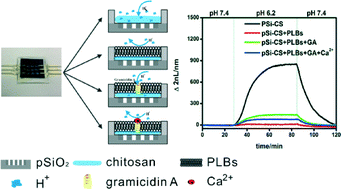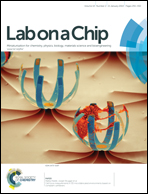Label-free study of the function of ion channel protein on a microfluidic optical sensor integrated with artificial cell membrane†
Abstract
A label-free optical sensor was constructed by integrating pH sensing material and supported phospholipid bilayers (SPBs) in a microfluidic chip. The pH sensing material was composed of a double layer structure consisting of chitosan hydrogel and electrochemically etched porous silicon. The pH change in the microchip could induce a reversible swelling of the chitosan hydrogel layer and consequently caused a shift in effective optical thickness (EOT) of the double layer, which could be observed by Fourier transformed reflectometric interference spectroscopy (FT-RIS). After phospholipid bilayers (PLBs) were self-assembled on the sensing layer, the EOT almost remained constant during the cycling of pH from 7.4 to 6.2, indicating the blockage of H+ translocation by the PLBs. For studying the behavior of ion channel protein, gramicidin A, a typical ion channel protein, was inserted in the SPBs for mimicking the ion transportation function of cell membrane. Due to the H+ transportation capability of gramicidin A, the optical response to pH change could partially recover. In the presence of Ca2+, the pore of the ion channel protein was blocked, causing a significant decrease in the EOT response upon pH change. The bio-functionalized microfluidic sensor fabricated in this work will provide a reliable platform for studying the function of ion channel protein, which is an important class of drug targets.


 Please wait while we load your content...
Please wait while we load your content...